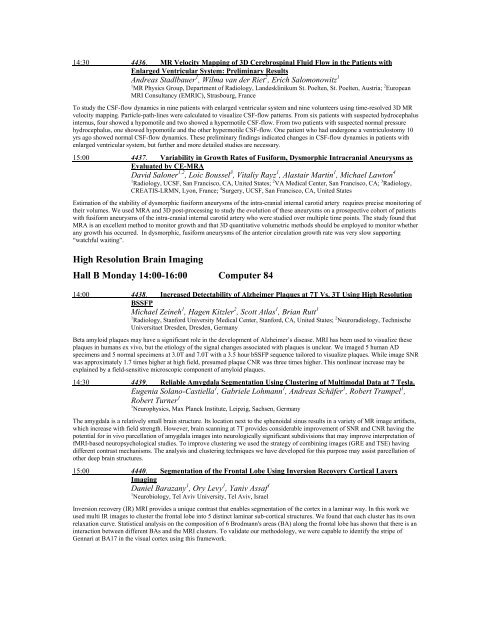Electronic Posters: Neuroimaging - ismrm
Electronic Posters: Neuroimaging - ismrm
Electronic Posters: Neuroimaging - ismrm
Create successful ePaper yourself
Turn your PDF publications into a flip-book with our unique Google optimized e-Paper software.
14:30 4436. MR Velocity Mapping of 3D Cerebrospinal Fluid Flow in the Patients with<br />
Enlarged Ventricular System: Preliminary Results<br />
Andreas Stadlbauer 1 , Wilma van der Riet 2 , Erich Salomonowitz 1<br />
1 MR Physics Group, Department of Radiology, Landesklinikum St. Poelten, St. Poelten, Austria; 2 European<br />
MRI Consultancy (EMRIC), Strasbourg, France<br />
To study the CSF-flow dynamics in nine patients with enlarged ventricular system and nine volunteers using time-resolved 3D MR<br />
velocity mapping. Particle-path-lines were calculated to visualize CSF-flow patterns. From six patients with suspected hydrocephalus<br />
internus, four showed a hypomotile and two showed a hypermotile CSF-flow. From two patients with suspected normal pressure<br />
hydrocephalus, one showed hypomotile and the other hypermotile CSF-flow. One patient who had undergone a ventriculostomy 10<br />
yrs ago showed normal CSF-flow dynamics. These preliminary findings indicated changes in CSF-flow dynamics in patients with<br />
enlarged ventricular system, but further and more detailed studies are necessary.<br />
15:00 4437. Variability in Growth Rates of Fusiform, Dysmorphic Intracranial Aneurysms as<br />
Evaluated by CE-MRA<br />
David Saloner 1,2 , Loic Boussel 3 , Vitaliy Rayz 1 , Alastair Martin 1 , Michael Lawton 4<br />
1 Radiology, UCSF, San Francisco, CA, United States; 2 VA Medical Center, San Francisco, CA; 3 Radiology,<br />
CREATIS-LRMN, Lyon, France; 4 Surgery, UCSF, San Francisco, CA, United States<br />
Estimation of the stability of dysmorphic fusiform aneurysms of the intra-cranial internal carotid artery requires precise monitoring of<br />
their volumes. We used MRA and 3D post-processing to study the evolution of these aneurysms on a prosepective cohort of patients<br />
with fusiform aneurysms of the intra-cranial internal carotid artery who were studied over multiple time points. The study found that<br />
MRA is an excellent method to monitor growth and that 3D quantitative volumetric methods should be employed to monitor whether<br />
any growth has occurred. In dysmorphic, fusiform aneurysms of the anterior circulation growth rate was very slow supporting<br />
“watchful waiting”.<br />
High Resolution Brain Imaging<br />
Hall B Monday 14:00-16:00 Computer 84<br />
14:00 4438. Increased Detectability of Alzheimer Plaques at 7T Vs. 3T Using High Resolution<br />
BSSFP<br />
Michael Zeineh 1 , Hagen Kitzler 2 , Scott Atlas 1 , Brian Rutt 1<br />
1 Radiology, Stanford University Medical Center, Stanford, CA, United States; 2 Neuroradiology, Technische<br />
Universitaet Dresden, Dresden, Germany<br />
Beta amyloid plaques may have a significant role in the development of Alzheimer’s disease. MRI has been used to visualize these<br />
plaques in humans ex vivo, but the etiology of the signal changes associated with plaques is unclear. We imaged 5 human AD<br />
specimens and 5 normal specimens at 3.0T and 7.0T with a 3.5 hour bSSFP sequence tailored to visualize plaques. While image SNR<br />
was approximately 1.7 times higher at high field, presumed plaque CNR was three times higher. This nonlinear increase may be<br />
explained by a field-sensitive microscopic component of amyloid plaques.<br />
14:30 4439. Reliable Amygdala Segmentation Using Clustering of Multimodal Data at 7 Tesla.<br />
Eugenia Solano-Castiella 1 , Gabriele Lohmann 1 , Andreas Schäfer 1 , Robert Trampel 1 ,<br />
Robert Turner 1<br />
1 Neurophysics, Max Planck Institute, Leipzig, Sachsen, Germany<br />
The amygdala is a relatively small brain structure. Its location next to the sphenoidal sinus results in a variety of MR image artifacts,<br />
which increase with field strength. However, brain scanning at 7T provides considerable improvement of SNR and CNR having the<br />
potential for in vivo parcellation of amygdala images into neurologically significant subdivisions that may improve interpretation of<br />
fMRI-based neuropsychological studies. To improve clustering we used the strategy of combining images (GRE and TSE) having<br />
different contrast mechanisms. The analysis and clustering techniques we have developed for this purpose may assist parcellation of<br />
other deep brain structures.<br />
15:00 4440. Segmentation of the Frontal Lobe Using Inversion Recovery Cortical Layers<br />
Imaging<br />
Daniel Barazany 1 , Ory Levy 1 , Yaniv Assaf 1<br />
1 Neurobiology, Tel Aviv University, Tel Aviv, Israel<br />
Inversion recovery (IR) MRI provides a unique contrast that enables segmentation of the cortex in a laminar way. In this work we<br />
used multi IR images to cluster the frontal lobe into 5 distinct laminar sub-cortical structures. We found that each cluster has its own<br />
relaxation curve. Statistical analysis on the composition of 6 Brodmann's areas (BA) along the frontal lobe has shown that there is an<br />
interaction between different BAs and the MRI clusters. To validate our methodology, we were capable to identify the stripe of<br />
Gennari at BA17 in the visual cortex using this framework.
















